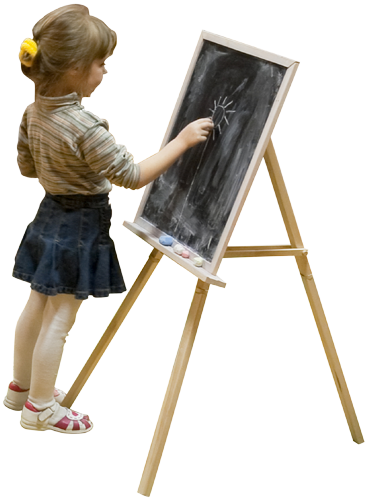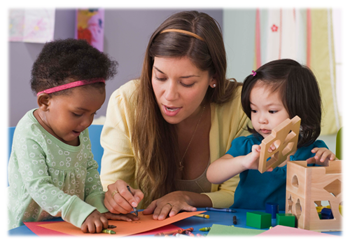

Chapter 1. Child Care: The Best Practices
Synopsis
Child Care: The Best Practices
Author

Amy Obegi and Sheridan Dewolf, Grossmont College
Synopsis
In this activity, you will learn about the need for and components of high-quality child care in the United States today. This activity contains a number of observational video clips from the Grossmont Child Care Center in El Cajon, California. The footage in these videos will allow you to view high-quality child care in action.
REFERENCES
American Academy of Pediatrics. (2005). Quality early education and child care from birth to kindergarten. Pediatrics, 115, 187–191.
Carnegie Corporation of New York. (1994). Starting points: Meeting the needs of our youngest children. New York, NY: Carnegie Corporation.
Children’s Defense Fund. (2005, April). Issue basics: Child care basics. Washington, DC: CDF.
The National Association for the Education of Young Children. (2005). Early Childhood Program Standards. Washington, DC: NAEYC.
Bureau of Labor Statistics. (2004). Employment characteristics of families in 2004. Washington, DC: U.S. Department of Labor.
Further Resources for Child Care: The Best Practices
The NAEYC has published a resource titled “10 Signs of a Great Preschool.” To view this resource, go to http://www.naeyc.org/resources/eyly/1996/01.htm. This handout lists ways to evaluate whether a classroom curriculum is high-quality and developmentally appropriate.
The Need for Quality Child Care

The need for child care in the United States is clear. Sixty-two percent of mothers with children younger than six are in the workforce (Bureau of Labor Statistics, 2004). Twelve million preschoolers—half of them infants and toddlers—are in child care every day (Children’s Defense Fund, 2005). The quality of child care varies considerably as does the impact of this care on the developing child.
Children in good-quality center day care show greater math and language skills, stronger thinking and attention skills, and fewer behavior problems than children in lower-quality programs (Carnegie Corporation of New York, 1994). For children from low-income families, high-quality child care can yield greater school success, higher graduation rates, lower juvenile crime, decreased need for special education services, and lower adolescent pregnancy rates. Poor-quality care at home or in a child care facility has been shown to have negative effects on language and social development as well as on later school performance (American Academy of Pediatrics, 2005).
Many organizations have shared research results to develop lists of indicators of good quality programs. Although some details differ, all organizations agree that child care should be consistent, developmentally sound, and emotionally supportive (American Academy of Pediatrics, 2005).
Caregivers and Children

The transition from homecare to child care is a significant one in the lives of children and their families. One of the most important indicators of quality child care is the caregiver’s ability to connect with children and families through the formation of meaningful relationships. Children learn best when they are in a setting that helps them feel safe, secure, and nurtured. Therefore, caregivers need to get to know each child and become responsive to children’s individual personalities and developmental needs. In practice, this can be seen when caregivers are careful observers of children and when caregivers get down to a child’s level, converse with children in a warm, meaningful way, and help children to feel included with peers.
Play the video to observe a caregiver’s relationship with a child.
Strategies for Developing Relationships: Primary Caregiving

Daily interactions build relationships between caregivers and children, but there are specific strategies suggested by the Program for Infant Toddler Caregivers (PITC) that help facilitate the development of relationships between caregivers and children.
With the strategy of primary caregiving, one caregiver is principally responsible for a small group. The primary caregiver performs all the basic caregiving routines with the children in his or her group, including feeding, napping, diapering, and toileting. The primary caregiver also gets to know the children and their families intimately. All teachers in the room function as a team helping the children when needed, yet with primary caregiving, the children always know that they can turn to a trusted, predictable person.
Play the video to observe the strategy of primary caregiving in action.
Strategies for Developing Relationships: Continuity of Care

With continuity of care, children and caregivers stay together for the duration of time that the child is in care. Rather than passing children on to new teachers when the children become a particular age, the program commits to keeping primary relationships together. The children’s and parents’ stress and sense of loss are lessened when the children do not have to readjust to new caregivers each year. Teachers get to know the temperaments, developmental needs, and interests of the children over time, and this helps to build strong, lasting relationships.
Play the video to find out more about the advantages of continuity of care as an element of best practices in child care.
Strategies for Developing Relationships: Small Groups

Keeping overall group size small helps caregivers to spend more time with each child and consequently builds closer relationships between caregivers and children. Small groups also help children to engage in more focused play and to get to know their peers more intimately. Research has consistently shown that low teacher-to-child ratios and small groups are predictors of high-quality child care.
Play the video to view the strategy of small groups in action.
1.
Match the correct description with each strategy for developing relationships between caregivers and children in child care. Click on an item in the left column, and then click the item in the right column that matches it.
primary caregiving continuity of care small groups | Low number of children in a classroom One caregiver who is principally responsible for the care of a small group Staying with one child for the duration of time that the child is in care |
| Correct Matches: | |
Best Practices: Building Strong Relationships with Families

The establishment and maintenance of secure relationships with children should begin with the child’s family. Quality child care settings recognize that family is the child’s first teacher. Child caregivers work closely with families to establish a strong home-school connection. Home-child care collaborations help to meet the individual needs of children and send home the message that the families of children are valued. To establish relationships with families, caregivers need to be respectful of diverse family structures as well as cultural and linguistic differences among families in either family day care or center day care. Parents should be welcomed into the program, and their input should be solicited and considered.
Here are some ways that quality child care programs build strong relationships with families:
– intake interviews
– daily communication
– parent-teacher conferences
– classroom displays of family photos
– on-site family gatherings
Play the video to view how these caregivers develop strong relationships with children and their families.
Best Practices: The Curriculum

Quality child care is not babysitting. It is designed with the enhancement of the whole child in mind. This means that the curriculum engages children socially, emotionally, physically, cognitively, linguistically, and creatively. The careful and thoughtful planning of activities helps children to develop skills in all developmental domains to prepare them for later school success. Careful planning does not mean forcing all children to do the same activity at the same time throughout the day. Curriculum should be individualized and set up within the child’s zone of proximal development (ZPD). Quality programs can achieve this by creating activity centers throughout the classroom (art, science, math, literacy, dramatic play, gross motor, the use of manipulatives, and so forth) for children to explore at their own pace and to interact with in a way that suits their developmental level and interests. Programs should balance group and individual activities.
Caregivers watch how the children are engaged with the materials and gauge how to adjust and extend the children’s play. In this way, curriculum is co-constructed with the children because the children and caregivers are both involved in the exploration and planning of daily curriculum.
Documenting Curriculum

Effective curriculum planning comes from carefully observing children’s play, reflecting upon the meaning and learning embedded within that play, and recording what is observed. Documenting children’s work helps to make the learning visible and helps the teacher to create planning possibilities for upcoming curriculum. Documentation can be done through photos, anecdotal notes, and recordings of children’s words and ideas. It can also be accomplished through formal assessments of teachers. Documentation supports the home-school connection by providing concrete evidence of the child’s activities at child care.
2.
If you were employed by this center, what might you include in any anecdotal notes about the activities and children in this video clip?
Best Practices: The Environment

A well-planned environment is a crucial component of high-quality programs. Children pick up cues from the environment that impact their behavior, comfort level, and ability to focus and learn. Quality environments should be safe, healthy, well organized, well equipped, and maintained. State licensing requirements provide specific mandates for the standards that child care environments must uphold for the health and safety of children.
Most importantly, quality environments should be aesthetically pleasing and comfortable with places for active and quiet play. They should be welcoming to children and families of diverse cultural backgrounds. They should be accessible to children of all abilities. The environment should also provide child-sized seating and access to materials as well as comfortable places for adults to interact with children. Children’s work should be visible in the environment with art, photos, projects, or other physical displays of the children’s learning.
Best Practices: Administration and Staff

High-quality programs need a good infrastructure to support these best practices. A quality program should exceed licensing requirements and regulations and meet accreditation standards from professional organizations, such as the National Association for the Education of Young Children (NAEYC) or the National Association of Family Child Care. Policies, procedures, and systems that support a stable staff include adequate compensation and benefits for personnel, opportunities for staff development, and regular evaluations. Teachers and directors should have the educational qualifications, knowledge, and professional commitment necessary to promote children’s learning and development (NAEYC, 2005).
Some Final Thoughts

– Quality child care begins with relationships with children and families.
– A successful and stable child care program includes a solid administrative infrastructure of well-trained staff with adequate compensation, low staff turnover, low teacher to child ratios, and a clear philosophy.
– In quality programs, curriculum is co-constructed and based on observation and documentation that includes input from children and families. The curriculum is individualized to meet the needs of the whole child so that he or she is engaged.
– In quality child care programs, teachers use a variety of different teaching techniques to build an environment that is developmentally appropriate.
– Most importantly, a child care program should facilitate a sense of wonder and joy and a love of lifelong learning.
Play the video to view children in a center day care.
Some Final Thoughts (continued)

3.
In what way is the video an example of high-quality child care? What do you think of as the most important component of child care in this particular video clip?
Assessment: Check Your Understanding

4.
1. Research on the indicators of quality child care show that it should be consistent, developmentally sound, and emotionally supportive.
Assessment: Check Your Understanding
5.
2. One of the most important indicators of quality child care is:

Assessment: Check Your Understanding

6.
3. The most important relationship in child care is between the caregiver and the child.
Assessment: Check Your Understanding

7.
4. The goal of the curriculum in child care is to promote later school success by fostering children’s learning in which area(s)?
Assessment: Check Your Understanding

8.
5. The most important quality of either a family day care or center day care environment is:
Congratulations! You have completed this activity.Total Score: x out of x points (x%) You have received a provisional score for your essay answers, which have been submitted to your instructor.